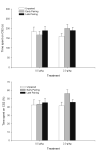Adolescent but not adult rats exhibit ethanol-mediated appetitive second-order conditioning
- PMID: 18782343
- PMCID: PMC2588482
- DOI: 10.1111/j.1530-0277.2008.00789.x
Adolescent but not adult rats exhibit ethanol-mediated appetitive second-order conditioning
Abstract
Background: Adolescent rats are less sensitive to the sedative effects of ethanol than older animals. They also seem to perceive the reinforcing properties of ethanol. However, unlike neonates or infants, ethanol-mediated appetitive behavior is yet to be clearly shown in adolescents. Appetitive ethanol reinforcement was assessed in adolescent (postnatal day 33, P33) and adult rats (P71) through second-order conditioning (SOC).
Methods: On P32 or P70, animals were intragastrically administered ethanol (0.5 or 2.0 g/kg) paired with intra-oral pulses of sucrose (CS(1), first-order conditioning phase). CS(1) delivery took place either 5-20 (early pairing) or 30-45 minutes (late pairing) following ethanol administration. The time interval between CS(1) exposure and ethanol administration was 240 minutes in unpaired controls. On P33 or P71, animals were presented the CS(1) (second-order conditioning phase) in a distinctive chamber (CS(2), second-order conditioning). Then they were tested for CS(2) preference.
Results: Early and late paired adolescents, but not adults, had greater preference for the CS(2) than controls, a result indicative of ontogenetic variation in ethanol-mediated reinforcement. During the CS(1)-CS(2) associative phase, paired adolescents given 2.0 g/kg ethanol wall-climbed more than controls. Blood and brain ethanol levels associated with the 0.5 and 2.0 g/kg doses at the onset of each conditioning phase did not differ substantially across age, with mean blood ethanol concentration of 38 and 112 mg%.
Conclusions: These data indicate age-related differences between adolescent and adult rats in terms of sensitivity to ethanol's motivational effects. Adolescents exhibited high sensitivity for ethanol's appetitive effects. These animals also showed ethanol-mediated behavioral activation during the SOC phase. The SOC preparation provides a valuable conditioning model for assessing ethanol's motivational effects across ontogeny.
Figures




Similar articles
-
Differential motivational properties of ethanol during early ontogeny as a function of dose and postadministration time.Alcohol. 2007 Feb;41(1):41-55. doi: 10.1016/j.alcohol.2007.01.005. Alcohol. 2007. PMID: 17452298 Free PMC article.
-
Ethanol induces second-order aversive conditioning in adolescent and adult rats.Alcohol. 2011 Feb;45(1):45-55. doi: 10.1016/j.alcohol.2010.10.004. Alcohol. 2011. PMID: 21187242 Free PMC article.
-
Infantile sensitivity to ethanol's motivational effects: Ethanol reinforcement during the third postnatal week.Alcohol Clin Exp Res. 2006 Sep;30(9):1506-19. doi: 10.1111/j.1530-0277.2006.00182.x. Alcohol Clin Exp Res. 2006. PMID: 16930213
-
Assessing appetitive, aversive, and negative ethanol-mediated reinforcement through an immature rat model.Neurosci Biobehav Rev. 2009 Jun;33(6):953-74. doi: 10.1016/j.neubiorev.2009.03.008. Epub 2009 Mar 24. Neurosci Biobehav Rev. 2009. PMID: 19428502 Free PMC article. Review.
-
Apparatus bias and place conditioning with ethanol in mice.Psychopharmacology (Berl). 2003 Dec;170(4):409-22. doi: 10.1007/s00213-003-1559-y. Epub 2003 Oct 30. Psychopharmacology (Berl). 2003. PMID: 12955296 Review.
Cited by
-
Negative Affect and Excessive Alcohol Intake Incubate during Protracted Withdrawal from Binge-Drinking in Adolescent, But Not Adult, Mice.Front Psychol. 2017 Jul 6;8:1128. doi: 10.3389/fpsyg.2017.01128. eCollection 2017. Front Psychol. 2017. PMID: 28729845 Free PMC article.
-
Sensitivity to ethanol and other hedonic stimuli in an animal model of adolescence: implications for prevention science?Dev Psychobiol. 2010 Apr;52(3):236-43. doi: 10.1002/dev.20457. Dev Psychobiol. 2010. PMID: 20222058 Free PMC article. Review.
-
Ethanol-induced locomotor activity in adolescent rats and the relationship with ethanol-induced conditioned place preference and conditioned taste aversion.Dev Psychobiol. 2013 May;55(4):429-42. doi: 10.1002/dev.21048. Epub 2012 May 16. Dev Psychobiol. 2013. PMID: 22592597 Free PMC article.
-
Chronic intermittent ethanol exposure during adolescence: Effects on stress-induced social alterations and social drinking in adulthood.Brain Res. 2017 Jan 1;1654(Pt B):145-156. doi: 10.1016/j.brainres.2016.03.050. Epub 2016 Apr 2. Brain Res. 2017. PMID: 27048754 Free PMC article.
-
Alcohol and stress exposure across the lifespan are key risk factors for Alzheimer's Disease and cognitive decline.Neurobiol Stress. 2024 Jan 4;29:100605. doi: 10.1016/j.ynstr.2024.100605. eCollection 2024 Mar. Neurobiol Stress. 2024. PMID: 38268931 Free PMC article.
References
-
- Adriani W, Chiarotti F, Laviola G. Elevated novelty seeking and peculiar D-amphetamine sensitization in periadolescent mice compared with adult mice. Behav Neurosci. 1998;112:1152–1166. - PubMed
-
- Adriani W, Laviola G. A unique hormonal and behavioral hyporesponsivity to both forced novelty and d-amphetamine in periadolescent mice. Neuropharmacology. 2000;39:334–346. - PubMed
-
- Bienkowski P, Kuka P, Kowstowski W. Conditioned place preference after prolonged preexposure to ethanol. Pol J Pharmacol. 1995;47:185–187.
-
- Bozarth M. Evidence for the rewarding effects of ethanol using the Conditioned Place Preference method. Pharmachol Biochem Behav. 1990;35:485–487. - PubMed
-
- Cheslock S, Varlinskaya E, Petrov ES, Silveri MM, Spear LP, Spear NE. Ethanol as a reinforcer in the newborn’s first suckling experience. Alcohol Clin Exp Res. 2001;25:395–402. - PubMed
Publication types
MeSH terms
Substances
Grants and funding
- R37 MH035219/MH/NIMH NIH HHS/United States
- AA11960/AA/NIAAA NIH HHS/United States
- R01 AA016887/AA/NIAAA NIH HHS/United States
- AA12525/AA/NIAAA NIH HHS/United States
- R01 MH035219/MH/NIMH NIH HHS/United States
- MH035219/MH/NIMH NIH HHS/United States
- R37 AA012525/AA/NIAAA NIH HHS/United States
- AA015992/AA/NIAAA NIH HHS/United States
- R01 AA013098/AA/NIAAA NIH HHS/United States
- R01 AA015992/AA/NIAAA NIH HHS/United States
- R01 AA012525/AA/NIAAA NIH HHS/United States
- R01 AA011960/AA/NIAAA NIH HHS/United States
- AA013098/AA/NIAAA NIH HHS/United States
- AA16887/AA/NIAAA NIH HHS/United States
LinkOut - more resources
Full Text Sources
Medical
Research Materials
Miscellaneous

